Auditing Theory and Practice
VerifiedAdded on 2023/06/04
|13
|3083
|233
AI Summary
This article discusses the key audit events of BHP Billiton and their impact on audit planning. It also evaluates the risks of material misstatements and the compliance of financial reports with IFRSs and AASBs.
Contribute Materials
Your contribution can guide someone’s learning journey. Share your
documents today.
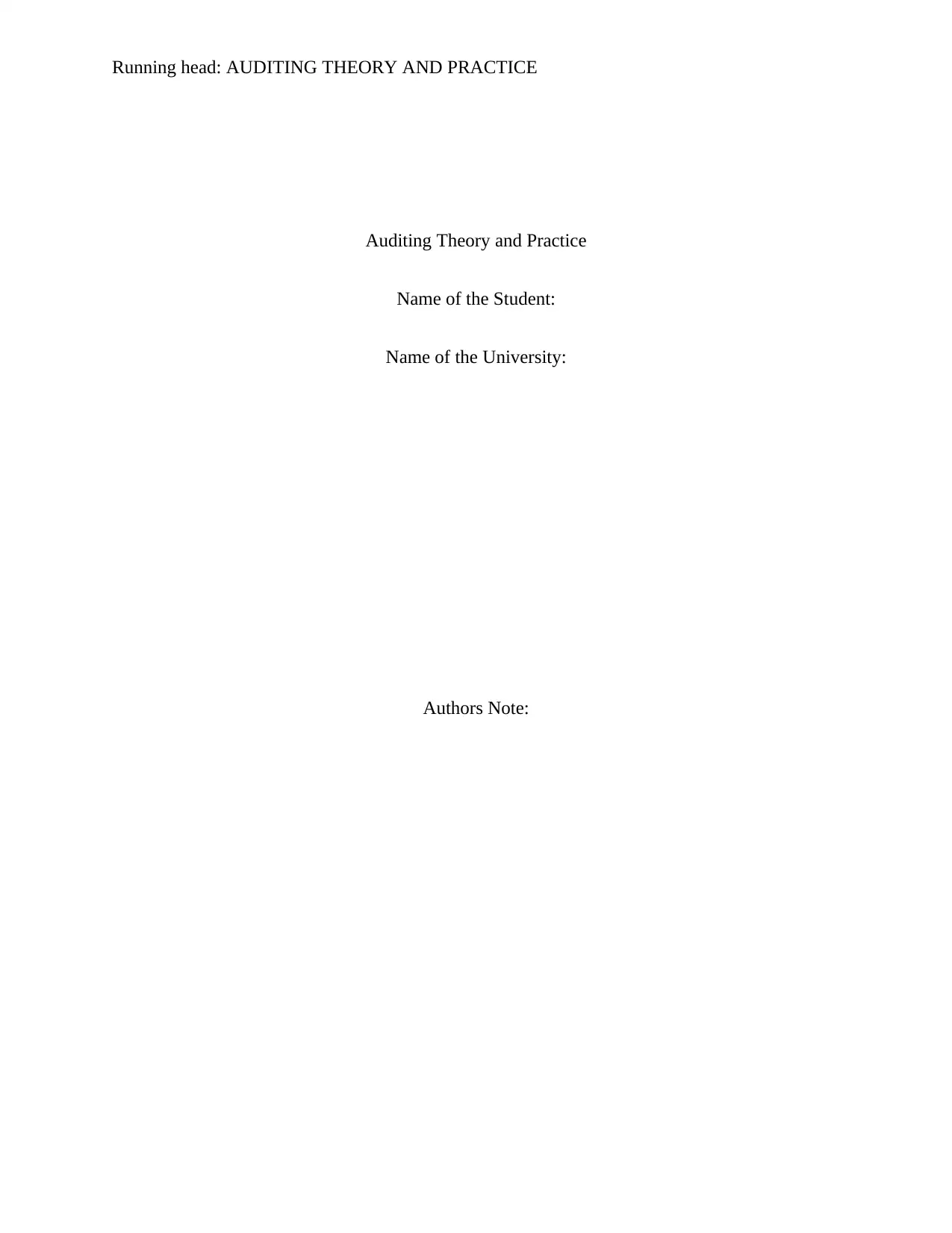
Running head: AUDITING THEORY AND PRACTICE
Auditing Theory and Practice
Name of the Student:
Name of the University:
Authors Note:
Auditing Theory and Practice
Name of the Student:
Name of the University:
Authors Note:
Secure Best Marks with AI Grader
Need help grading? Try our AI Grader for instant feedback on your assignments.

1
AUDITING THEORY AND PRACTICE
Contents
Introduction:....................................................................................................................................2
Answer 1:.........................................................................................................................................2
Answer 2:.........................................................................................................................................5
Conclusion:......................................................................................................................................9
References:....................................................................................................................................10
AUDITING THEORY AND PRACTICE
Contents
Introduction:....................................................................................................................................2
Answer 1:.........................................................................................................................................2
Answer 2:.........................................................................................................................................5
Conclusion:......................................................................................................................................9
References:....................................................................................................................................10
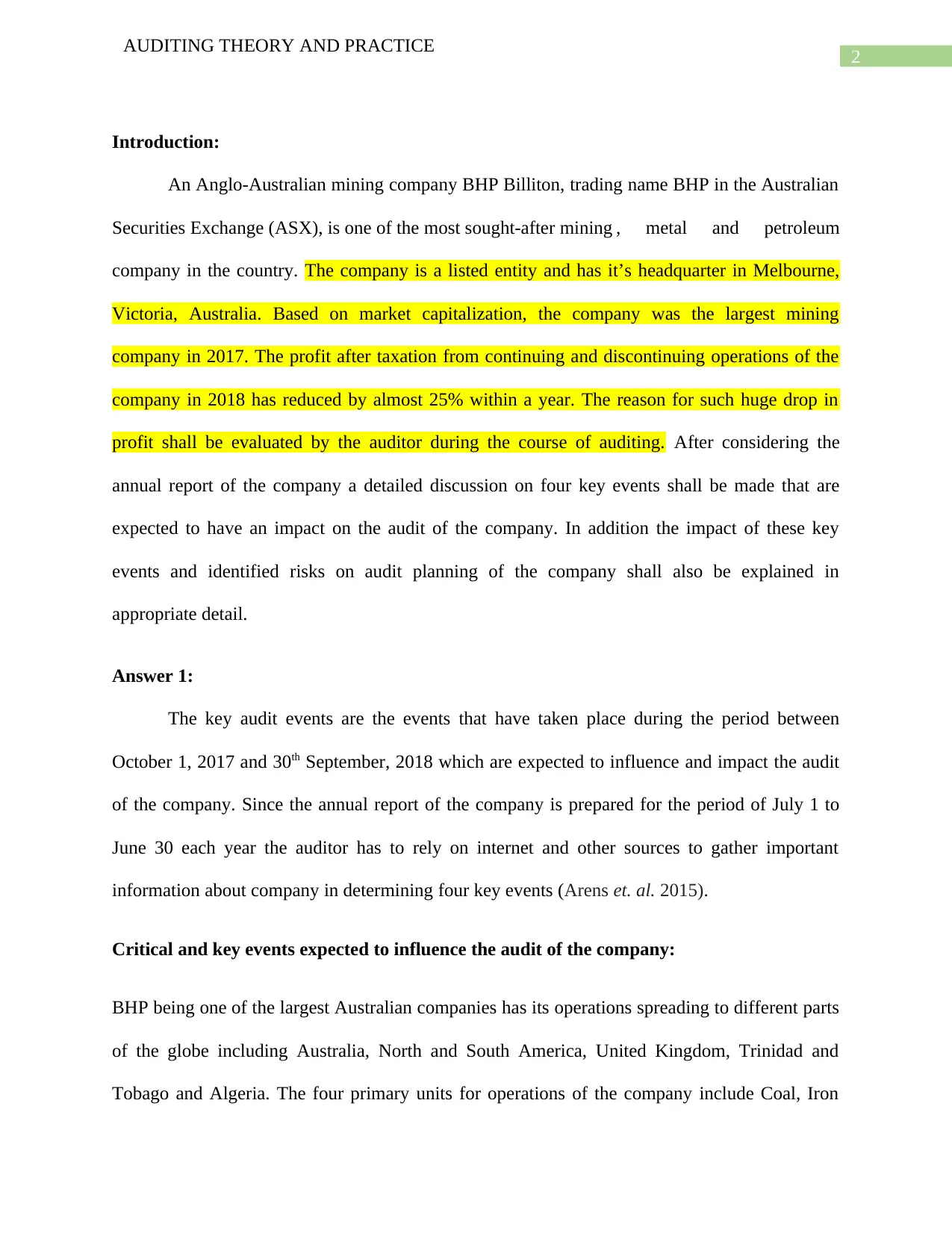
2
AUDITING THEORY AND PRACTICE
Introduction:
An Anglo-Australian mining company BHP Billiton, trading name BHP in the Australian
Securities Exchange (ASX), is one of the most sought-after mining , metal and petroleum
company in the country. The company is a listed entity and has it’s headquarter in Melbourne,
Victoria, Australia. Based on market capitalization, the company was the largest mining
company in 2017. The profit after taxation from continuing and discontinuing operations of the
company in 2018 has reduced by almost 25% within a year. The reason for such huge drop in
profit shall be evaluated by the auditor during the course of auditing. After considering the
annual report of the company a detailed discussion on four key events shall be made that are
expected to have an impact on the audit of the company. In addition the impact of these key
events and identified risks on audit planning of the company shall also be explained in
appropriate detail.
Answer 1:
The key audit events are the events that have taken place during the period between
October 1, 2017 and 30th September, 2018 which are expected to influence and impact the audit
of the company. Since the annual report of the company is prepared for the period of July 1 to
June 30 each year the auditor has to rely on internet and other sources to gather important
information about company in determining four key events (Arens et. al. 2015).
Critical and key events expected to influence the audit of the company:
BHP being one of the largest Australian companies has its operations spreading to different parts
of the globe including Australia, North and South America, United Kingdom, Trinidad and
Tobago and Algeria. The four primary units for operations of the company include Coal, Iron
AUDITING THEORY AND PRACTICE
Introduction:
An Anglo-Australian mining company BHP Billiton, trading name BHP in the Australian
Securities Exchange (ASX), is one of the most sought-after mining , metal and petroleum
company in the country. The company is a listed entity and has it’s headquarter in Melbourne,
Victoria, Australia. Based on market capitalization, the company was the largest mining
company in 2017. The profit after taxation from continuing and discontinuing operations of the
company in 2018 has reduced by almost 25% within a year. The reason for such huge drop in
profit shall be evaluated by the auditor during the course of auditing. After considering the
annual report of the company a detailed discussion on four key events shall be made that are
expected to have an impact on the audit of the company. In addition the impact of these key
events and identified risks on audit planning of the company shall also be explained in
appropriate detail.
Answer 1:
The key audit events are the events that have taken place during the period between
October 1, 2017 and 30th September, 2018 which are expected to influence and impact the audit
of the company. Since the annual report of the company is prepared for the period of July 1 to
June 30 each year the auditor has to rely on internet and other sources to gather important
information about company in determining four key events (Arens et. al. 2015).
Critical and key events expected to influence the audit of the company:
BHP being one of the largest Australian companies has its operations spreading to different parts
of the globe including Australia, North and South America, United Kingdom, Trinidad and
Tobago and Algeria. The four primary units for operations of the company include Coal, Iron
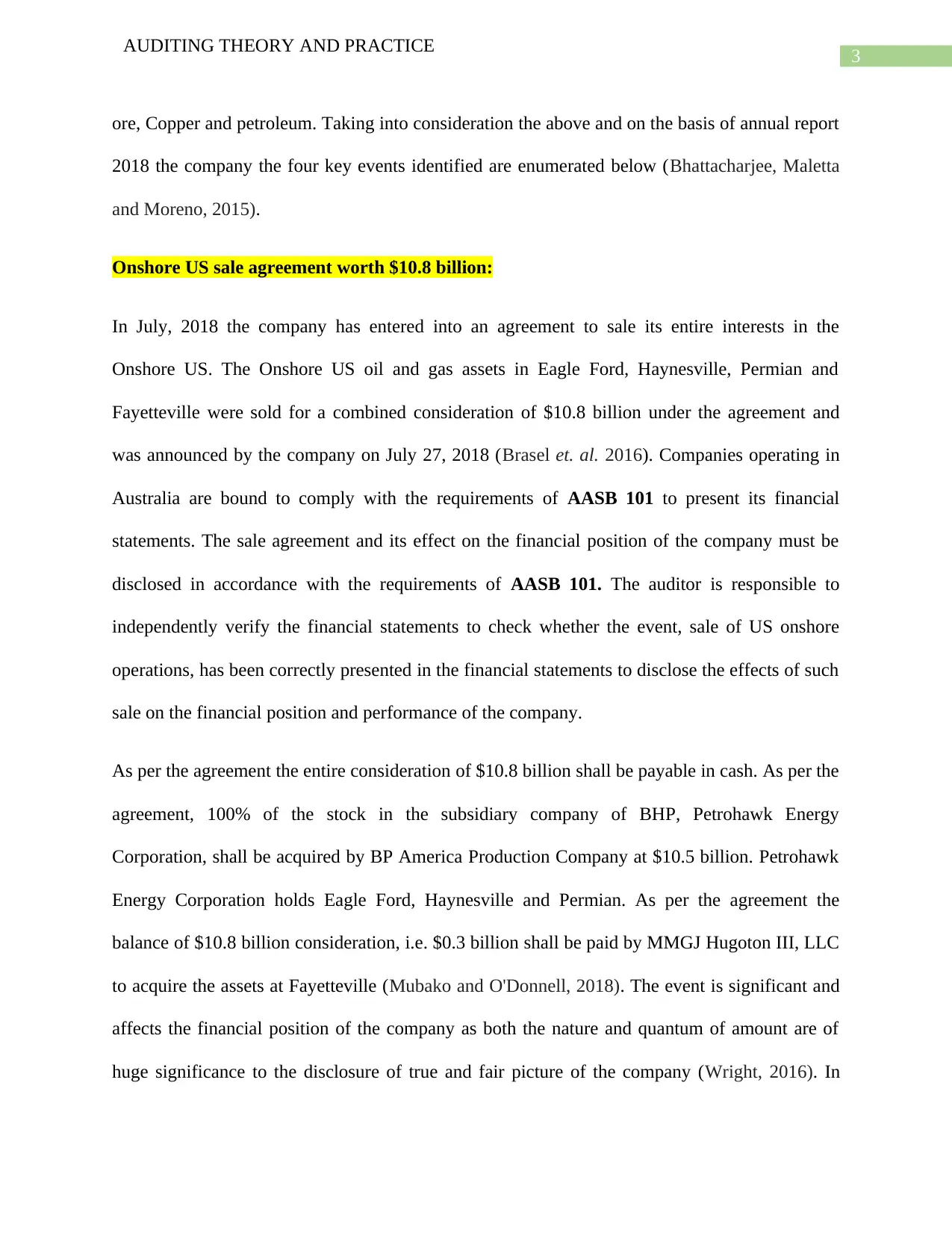
3
AUDITING THEORY AND PRACTICE
ore, Copper and petroleum. Taking into consideration the above and on the basis of annual report
2018 the company the four key events identified are enumerated below (Bhattacharjee, Maletta
and Moreno, 2015).
Onshore US sale agreement worth $10.8 billion:
In July, 2018 the company has entered into an agreement to sale its entire interests in the
Onshore US. The Onshore US oil and gas assets in Eagle Ford, Haynesville, Permian and
Fayetteville were sold for a combined consideration of $10.8 billion under the agreement and
was announced by the company on July 27, 2018 (Brasel et. al. 2016). Companies operating in
Australia are bound to comply with the requirements of AASB 101 to present its financial
statements. The sale agreement and its effect on the financial position of the company must be
disclosed in accordance with the requirements of AASB 101. The auditor is responsible to
independently verify the financial statements to check whether the event, sale of US onshore
operations, has been correctly presented in the financial statements to disclose the effects of such
sale on the financial position and performance of the company.
As per the agreement the entire consideration of $10.8 billion shall be payable in cash. As per the
agreement, 100% of the stock in the subsidiary company of BHP, Petrohawk Energy
Corporation, shall be acquired by BP America Production Company at $10.5 billion. Petrohawk
Energy Corporation holds Eagle Ford, Haynesville and Permian. As per the agreement the
balance of $10.8 billion consideration, i.e. $0.3 billion shall be paid by MMGJ Hugoton III, LLC
to acquire the assets at Fayetteville (Mubako and O'Donnell, 2018). The event is significant and
affects the financial position of the company as both the nature and quantum of amount are of
huge significance to the disclosure of true and fair picture of the company (Wright, 2016). In
AUDITING THEORY AND PRACTICE
ore, Copper and petroleum. Taking into consideration the above and on the basis of annual report
2018 the company the four key events identified are enumerated below (Bhattacharjee, Maletta
and Moreno, 2015).
Onshore US sale agreement worth $10.8 billion:
In July, 2018 the company has entered into an agreement to sale its entire interests in the
Onshore US. The Onshore US oil and gas assets in Eagle Ford, Haynesville, Permian and
Fayetteville were sold for a combined consideration of $10.8 billion under the agreement and
was announced by the company on July 27, 2018 (Brasel et. al. 2016). Companies operating in
Australia are bound to comply with the requirements of AASB 101 to present its financial
statements. The sale agreement and its effect on the financial position of the company must be
disclosed in accordance with the requirements of AASB 101. The auditor is responsible to
independently verify the financial statements to check whether the event, sale of US onshore
operations, has been correctly presented in the financial statements to disclose the effects of such
sale on the financial position and performance of the company.
As per the agreement the entire consideration of $10.8 billion shall be payable in cash. As per the
agreement, 100% of the stock in the subsidiary company of BHP, Petrohawk Energy
Corporation, shall be acquired by BP America Production Company at $10.5 billion. Petrohawk
Energy Corporation holds Eagle Ford, Haynesville and Permian. As per the agreement the
balance of $10.8 billion consideration, i.e. $0.3 billion shall be paid by MMGJ Hugoton III, LLC
to acquire the assets at Fayetteville (Mubako and O'Donnell, 2018). The event is significant and
affects the financial position of the company as both the nature and quantum of amount are of
huge significance to the disclosure of true and fair picture of the company (Wright, 2016). In
Secure Best Marks with AI Grader
Need help grading? Try our AI Grader for instant feedback on your assignments.
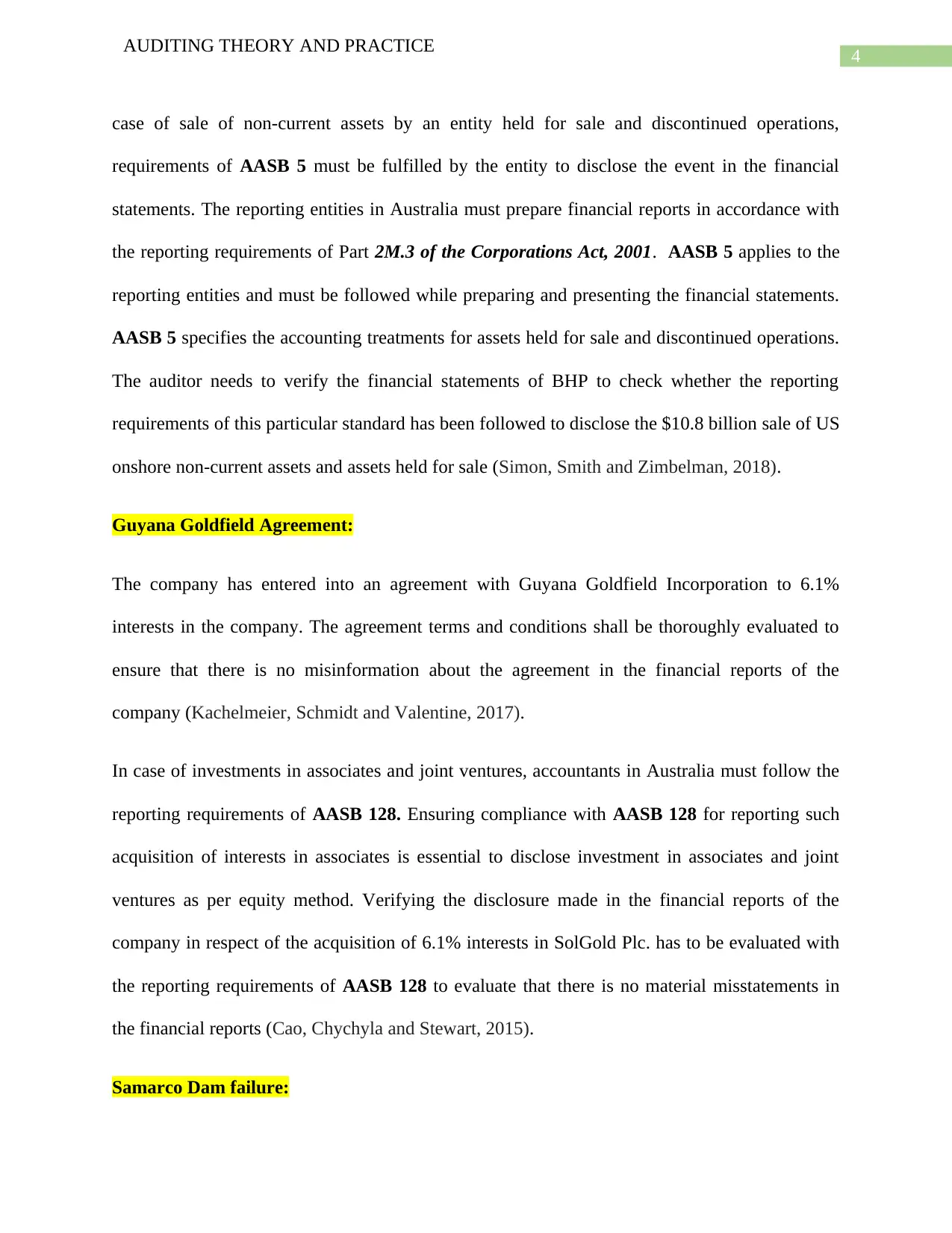
4
AUDITING THEORY AND PRACTICE
case of sale of non-current assets by an entity held for sale and discontinued operations,
requirements of AASB 5 must be fulfilled by the entity to disclose the event in the financial
statements. The reporting entities in Australia must prepare financial reports in accordance with
the reporting requirements of Part 2M.3 of the Corporations Act, 2001. AASB 5 applies to the
reporting entities and must be followed while preparing and presenting the financial statements.
AASB 5 specifies the accounting treatments for assets held for sale and discontinued operations.
The auditor needs to verify the financial statements of BHP to check whether the reporting
requirements of this particular standard has been followed to disclose the $10.8 billion sale of US
onshore non-current assets and assets held for sale (Simon, Smith and Zimbelman, 2018).
Guyana Goldfield Agreement:
The company has entered into an agreement with Guyana Goldfield Incorporation to 6.1%
interests in the company. The agreement terms and conditions shall be thoroughly evaluated to
ensure that there is no misinformation about the agreement in the financial reports of the
company (Kachelmeier, Schmidt and Valentine, 2017).
In case of investments in associates and joint ventures, accountants in Australia must follow the
reporting requirements of AASB 128. Ensuring compliance with AASB 128 for reporting such
acquisition of interests in associates is essential to disclose investment in associates and joint
ventures as per equity method. Verifying the disclosure made in the financial reports of the
company in respect of the acquisition of 6.1% interests in SolGold Plc. has to be evaluated with
the reporting requirements of AASB 128 to evaluate that there is no material misstatements in
the financial reports (Cao, Chychyla and Stewart, 2015).
Samarco Dam failure:
AUDITING THEORY AND PRACTICE
case of sale of non-current assets by an entity held for sale and discontinued operations,
requirements of AASB 5 must be fulfilled by the entity to disclose the event in the financial
statements. The reporting entities in Australia must prepare financial reports in accordance with
the reporting requirements of Part 2M.3 of the Corporations Act, 2001. AASB 5 applies to the
reporting entities and must be followed while preparing and presenting the financial statements.
AASB 5 specifies the accounting treatments for assets held for sale and discontinued operations.
The auditor needs to verify the financial statements of BHP to check whether the reporting
requirements of this particular standard has been followed to disclose the $10.8 billion sale of US
onshore non-current assets and assets held for sale (Simon, Smith and Zimbelman, 2018).
Guyana Goldfield Agreement:
The company has entered into an agreement with Guyana Goldfield Incorporation to 6.1%
interests in the company. The agreement terms and conditions shall be thoroughly evaluated to
ensure that there is no misinformation about the agreement in the financial reports of the
company (Kachelmeier, Schmidt and Valentine, 2017).
In case of investments in associates and joint ventures, accountants in Australia must follow the
reporting requirements of AASB 128. Ensuring compliance with AASB 128 for reporting such
acquisition of interests in associates is essential to disclose investment in associates and joint
ventures as per equity method. Verifying the disclosure made in the financial reports of the
company in respect of the acquisition of 6.1% interests in SolGold Plc. has to be evaluated with
the reporting requirements of AASB 128 to evaluate that there is no material misstatements in
the financial reports (Cao, Chychyla and Stewart, 2015).
Samarco Dam failure:

5
AUDITING THEORY AND PRACTICE
BHP Billiton has reported exceptional items to calculate profits from continuous operations. A
net loss of $2,970 million has been reported in the income statement of the BHP Billiton Group
in 2018 to calculate the amount of profit from continuous operations. Loss from exceptional
items include Samarco Dam failure. The group has reported net loss of $650 million from the
dam failure and included the same to account for the income from continuous operations.
Considering the size and nature of amount, the auditor must use substantive audit procedures to
corroborate necessary audit evidence to form his opinion on the amount of loss recognized for
the Samarco Dam failure and whether it is justified (Patterson and Smith, 2015).
US Tax reform and its effects:
US President on December 22, 2018 signed the Tax Cut and Job Act with the effects of the Act
starting from January 01, 2018. The corporate tax rate in the country lowered from 35% to 21%.
As a result the Group has to immediately re-measure its deferred tax position. Recognition of
income tax charge $2,320 million resulted in reduction of profit from continuous operations of
the group. The loss due to US Tax reforms has been reported under exceptional items. The basis
used in reporting the exceptional items and measurement technique used to measure the loss
from US tax reforms as well as Samarco Dam failure shall be evaluated by the auditor to report
on both the items (Knechel and Salterio, 2016).
Answer 2:
The purpose of carrying out an independent audit is to independently verify the financial
reports of an entity with an objective of providing an opinion on these reports as to their nature
and quality. In order to provide an appropriate opinion on the financial reports of an entity, an
auditor requires to collect necessary audit evidence to conclude about the nature and quality of
AUDITING THEORY AND PRACTICE
BHP Billiton has reported exceptional items to calculate profits from continuous operations. A
net loss of $2,970 million has been reported in the income statement of the BHP Billiton Group
in 2018 to calculate the amount of profit from continuous operations. Loss from exceptional
items include Samarco Dam failure. The group has reported net loss of $650 million from the
dam failure and included the same to account for the income from continuous operations.
Considering the size and nature of amount, the auditor must use substantive audit procedures to
corroborate necessary audit evidence to form his opinion on the amount of loss recognized for
the Samarco Dam failure and whether it is justified (Patterson and Smith, 2015).
US Tax reform and its effects:
US President on December 22, 2018 signed the Tax Cut and Job Act with the effects of the Act
starting from January 01, 2018. The corporate tax rate in the country lowered from 35% to 21%.
As a result the Group has to immediately re-measure its deferred tax position. Recognition of
income tax charge $2,320 million resulted in reduction of profit from continuous operations of
the group. The loss due to US Tax reforms has been reported under exceptional items. The basis
used in reporting the exceptional items and measurement technique used to measure the loss
from US tax reforms as well as Samarco Dam failure shall be evaluated by the auditor to report
on both the items (Knechel and Salterio, 2016).
Answer 2:
The purpose of carrying out an independent audit is to independently verify the financial
reports of an entity with an objective of providing an opinion on these reports as to their nature
and quality. In order to provide an appropriate opinion on the financial reports of an entity, an
auditor requires to collect necessary audit evidence to conclude about the nature and quality of
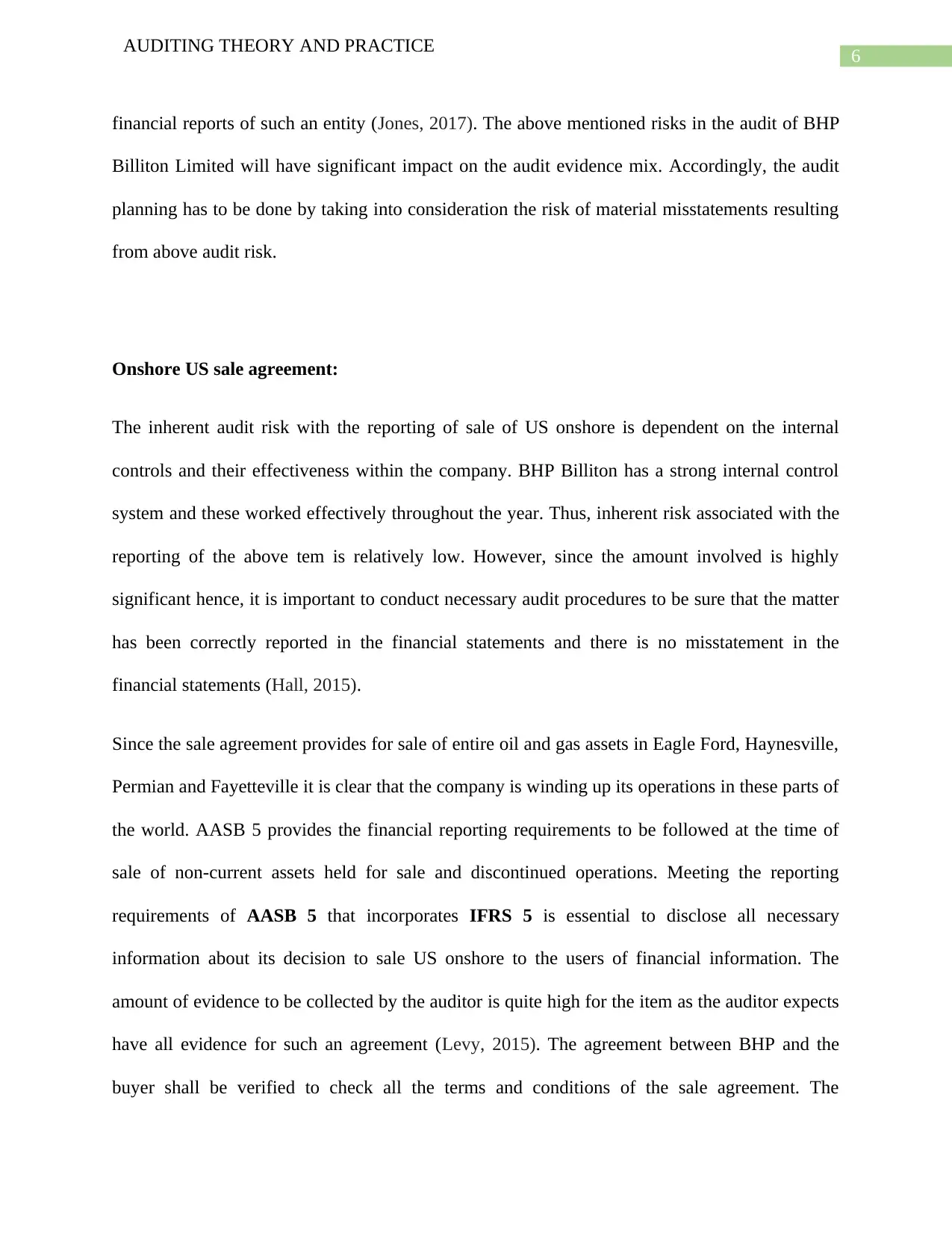
6
AUDITING THEORY AND PRACTICE
financial reports of such an entity (Jones, 2017). The above mentioned risks in the audit of BHP
Billiton Limited will have significant impact on the audit evidence mix. Accordingly, the audit
planning has to be done by taking into consideration the risk of material misstatements resulting
from above audit risk.
Onshore US sale agreement:
The inherent audit risk with the reporting of sale of US onshore is dependent on the internal
controls and their effectiveness within the company. BHP Billiton has a strong internal control
system and these worked effectively throughout the year. Thus, inherent risk associated with the
reporting of the above tem is relatively low. However, since the amount involved is highly
significant hence, it is important to conduct necessary audit procedures to be sure that the matter
has been correctly reported in the financial statements and there is no misstatement in the
financial statements (Hall, 2015).
Since the sale agreement provides for sale of entire oil and gas assets in Eagle Ford, Haynesville,
Permian and Fayetteville it is clear that the company is winding up its operations in these parts of
the world. AASB 5 provides the financial reporting requirements to be followed at the time of
sale of non-current assets held for sale and discontinued operations. Meeting the reporting
requirements of AASB 5 that incorporates IFRS 5 is essential to disclose all necessary
information about its decision to sale US onshore to the users of financial information. The
amount of evidence to be collected by the auditor is quite high for the item as the auditor expects
have all evidence for such an agreement (Levy, 2015). The agreement between BHP and the
buyer shall be verified to check all the terms and conditions of the sale agreement. The
AUDITING THEORY AND PRACTICE
financial reports of such an entity (Jones, 2017). The above mentioned risks in the audit of BHP
Billiton Limited will have significant impact on the audit evidence mix. Accordingly, the audit
planning has to be done by taking into consideration the risk of material misstatements resulting
from above audit risk.
Onshore US sale agreement:
The inherent audit risk with the reporting of sale of US onshore is dependent on the internal
controls and their effectiveness within the company. BHP Billiton has a strong internal control
system and these worked effectively throughout the year. Thus, inherent risk associated with the
reporting of the above tem is relatively low. However, since the amount involved is highly
significant hence, it is important to conduct necessary audit procedures to be sure that the matter
has been correctly reported in the financial statements and there is no misstatement in the
financial statements (Hall, 2015).
Since the sale agreement provides for sale of entire oil and gas assets in Eagle Ford, Haynesville,
Permian and Fayetteville it is clear that the company is winding up its operations in these parts of
the world. AASB 5 provides the financial reporting requirements to be followed at the time of
sale of non-current assets held for sale and discontinued operations. Meeting the reporting
requirements of AASB 5 that incorporates IFRS 5 is essential to disclose all necessary
information about its decision to sale US onshore to the users of financial information. The
amount of evidence to be collected by the auditor is quite high for the item as the auditor expects
have all evidence for such an agreement (Levy, 2015). The agreement between BHP and the
buyer shall be verified to check all the terms and conditions of the sale agreement. The
Paraphrase This Document
Need a fresh take? Get an instant paraphrase of this document with our AI Paraphraser
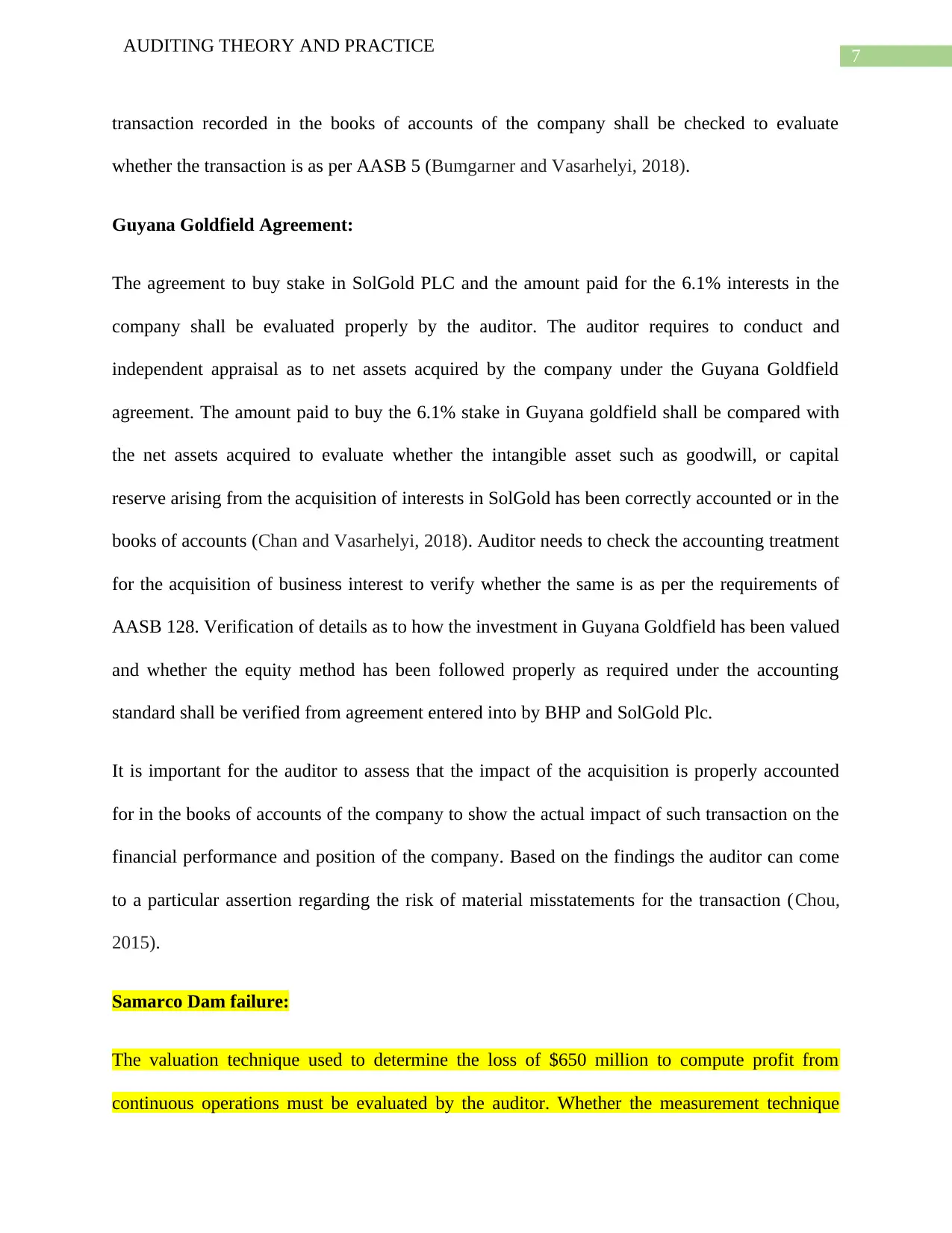
7
AUDITING THEORY AND PRACTICE
transaction recorded in the books of accounts of the company shall be checked to evaluate
whether the transaction is as per AASB 5 (Bumgarner and Vasarhelyi, 2018).
Guyana Goldfield Agreement:
The agreement to buy stake in SolGold PLC and the amount paid for the 6.1% interests in the
company shall be evaluated properly by the auditor. The auditor requires to conduct and
independent appraisal as to net assets acquired by the company under the Guyana Goldfield
agreement. The amount paid to buy the 6.1% stake in Guyana goldfield shall be compared with
the net assets acquired to evaluate whether the intangible asset such as goodwill, or capital
reserve arising from the acquisition of interests in SolGold has been correctly accounted or in the
books of accounts (Chan and Vasarhelyi, 2018). Auditor needs to check the accounting treatment
for the acquisition of business interest to verify whether the same is as per the requirements of
AASB 128. Verification of details as to how the investment in Guyana Goldfield has been valued
and whether the equity method has been followed properly as required under the accounting
standard shall be verified from agreement entered into by BHP and SolGold Plc.
It is important for the auditor to assess that the impact of the acquisition is properly accounted
for in the books of accounts of the company to show the actual impact of such transaction on the
financial performance and position of the company. Based on the findings the auditor can come
to a particular assertion regarding the risk of material misstatements for the transaction (Chou,
2015).
Samarco Dam failure:
The valuation technique used to determine the loss of $650 million to compute profit from
continuous operations must be evaluated by the auditor. Whether the measurement technique
AUDITING THEORY AND PRACTICE
transaction recorded in the books of accounts of the company shall be checked to evaluate
whether the transaction is as per AASB 5 (Bumgarner and Vasarhelyi, 2018).
Guyana Goldfield Agreement:
The agreement to buy stake in SolGold PLC and the amount paid for the 6.1% interests in the
company shall be evaluated properly by the auditor. The auditor requires to conduct and
independent appraisal as to net assets acquired by the company under the Guyana Goldfield
agreement. The amount paid to buy the 6.1% stake in Guyana goldfield shall be compared with
the net assets acquired to evaluate whether the intangible asset such as goodwill, or capital
reserve arising from the acquisition of interests in SolGold has been correctly accounted or in the
books of accounts (Chan and Vasarhelyi, 2018). Auditor needs to check the accounting treatment
for the acquisition of business interest to verify whether the same is as per the requirements of
AASB 128. Verification of details as to how the investment in Guyana Goldfield has been valued
and whether the equity method has been followed properly as required under the accounting
standard shall be verified from agreement entered into by BHP and SolGold Plc.
It is important for the auditor to assess that the impact of the acquisition is properly accounted
for in the books of accounts of the company to show the actual impact of such transaction on the
financial performance and position of the company. Based on the findings the auditor can come
to a particular assertion regarding the risk of material misstatements for the transaction (Chou,
2015).
Samarco Dam failure:
The valuation technique used to determine the loss of $650 million to compute profit from
continuous operations must be evaluated by the auditor. Whether the measurement technique
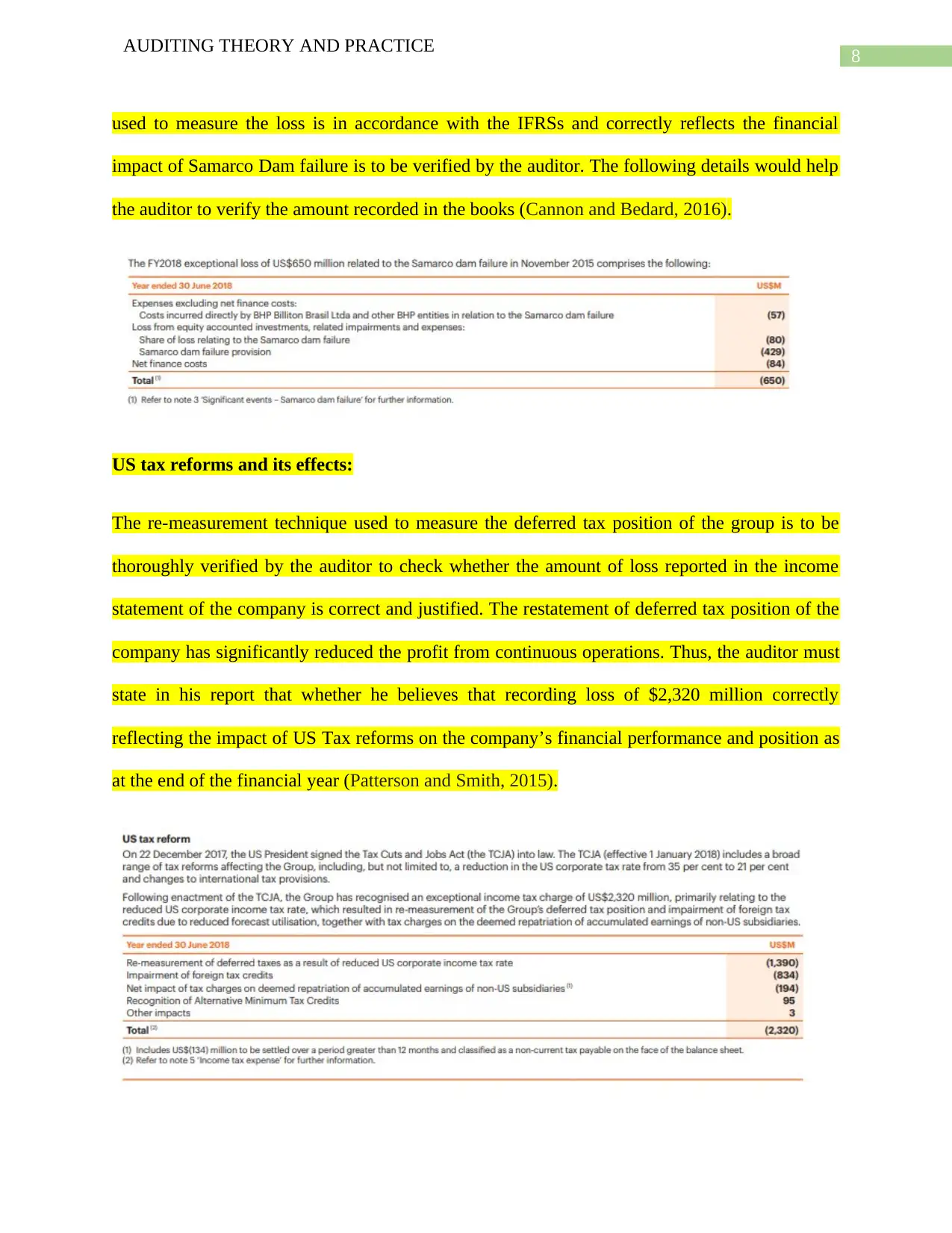
8
AUDITING THEORY AND PRACTICE
used to measure the loss is in accordance with the IFRSs and correctly reflects the financial
impact of Samarco Dam failure is to be verified by the auditor. The following details would help
the auditor to verify the amount recorded in the books (Cannon and Bedard, 2016).
US tax reforms and its effects:
The re-measurement technique used to measure the deferred tax position of the group is to be
thoroughly verified by the auditor to check whether the amount of loss reported in the income
statement of the company is correct and justified. The restatement of deferred tax position of the
company has significantly reduced the profit from continuous operations. Thus, the auditor must
state in his report that whether he believes that recording loss of $2,320 million correctly
reflecting the impact of US Tax reforms on the company’s financial performance and position as
at the end of the financial year (Patterson and Smith, 2015).
AUDITING THEORY AND PRACTICE
used to measure the loss is in accordance with the IFRSs and correctly reflects the financial
impact of Samarco Dam failure is to be verified by the auditor. The following details would help
the auditor to verify the amount recorded in the books (Cannon and Bedard, 2016).
US tax reforms and its effects:
The re-measurement technique used to measure the deferred tax position of the group is to be
thoroughly verified by the auditor to check whether the amount of loss reported in the income
statement of the company is correct and justified. The restatement of deferred tax position of the
company has significantly reduced the profit from continuous operations. Thus, the auditor must
state in his report that whether he believes that recording loss of $2,320 million correctly
reflecting the impact of US Tax reforms on the company’s financial performance and position as
at the end of the financial year (Patterson and Smith, 2015).
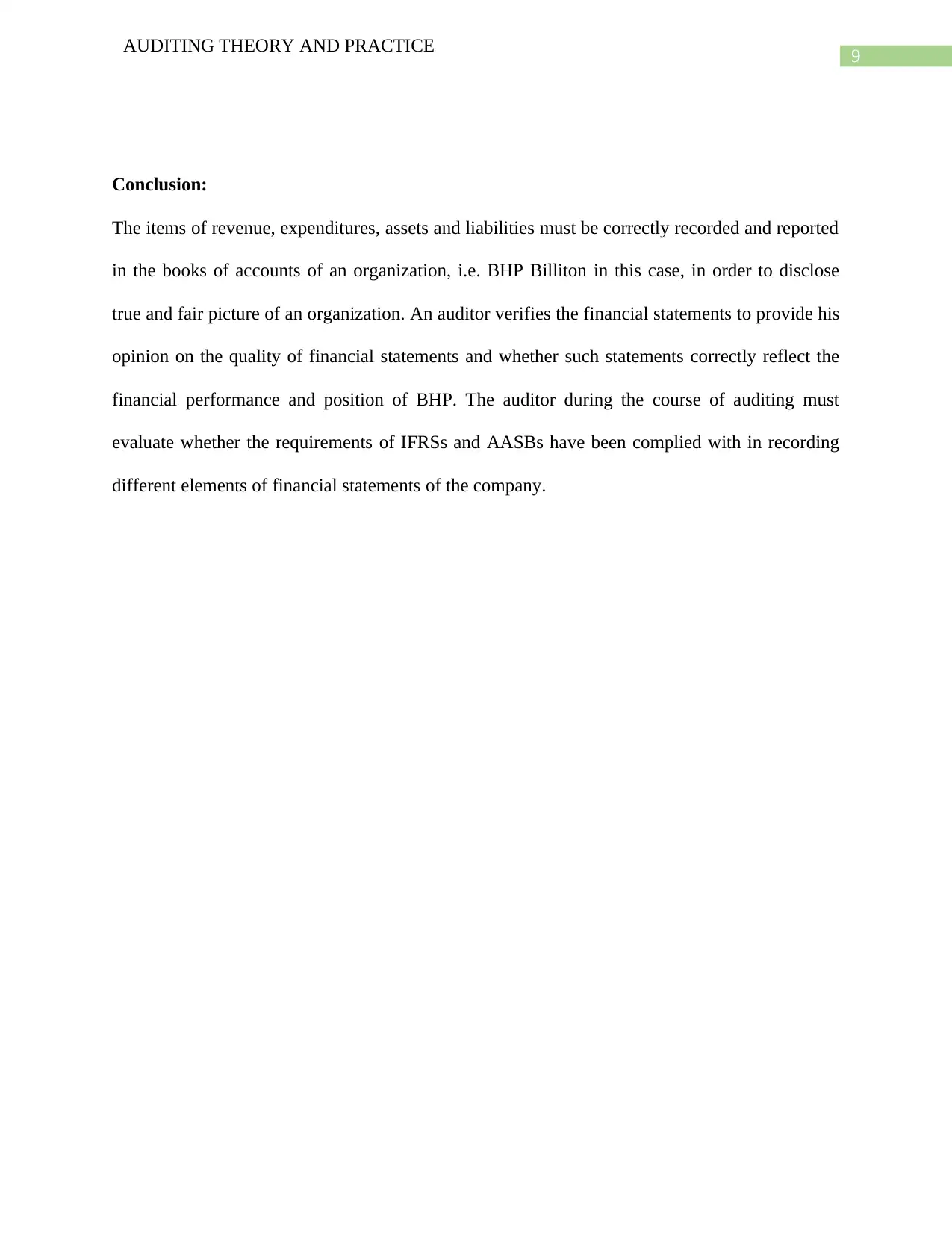
9
AUDITING THEORY AND PRACTICE
Conclusion:
The items of revenue, expenditures, assets and liabilities must be correctly recorded and reported
in the books of accounts of an organization, i.e. BHP Billiton in this case, in order to disclose
true and fair picture of an organization. An auditor verifies the financial statements to provide his
opinion on the quality of financial statements and whether such statements correctly reflect the
financial performance and position of BHP. The auditor during the course of auditing must
evaluate whether the requirements of IFRSs and AASBs have been complied with in recording
different elements of financial statements of the company.
AUDITING THEORY AND PRACTICE
Conclusion:
The items of revenue, expenditures, assets and liabilities must be correctly recorded and reported
in the books of accounts of an organization, i.e. BHP Billiton in this case, in order to disclose
true and fair picture of an organization. An auditor verifies the financial statements to provide his
opinion on the quality of financial statements and whether such statements correctly reflect the
financial performance and position of BHP. The auditor during the course of auditing must
evaluate whether the requirements of IFRSs and AASBs have been complied with in recording
different elements of financial statements of the company.
Secure Best Marks with AI Grader
Need help grading? Try our AI Grader for instant feedback on your assignments.
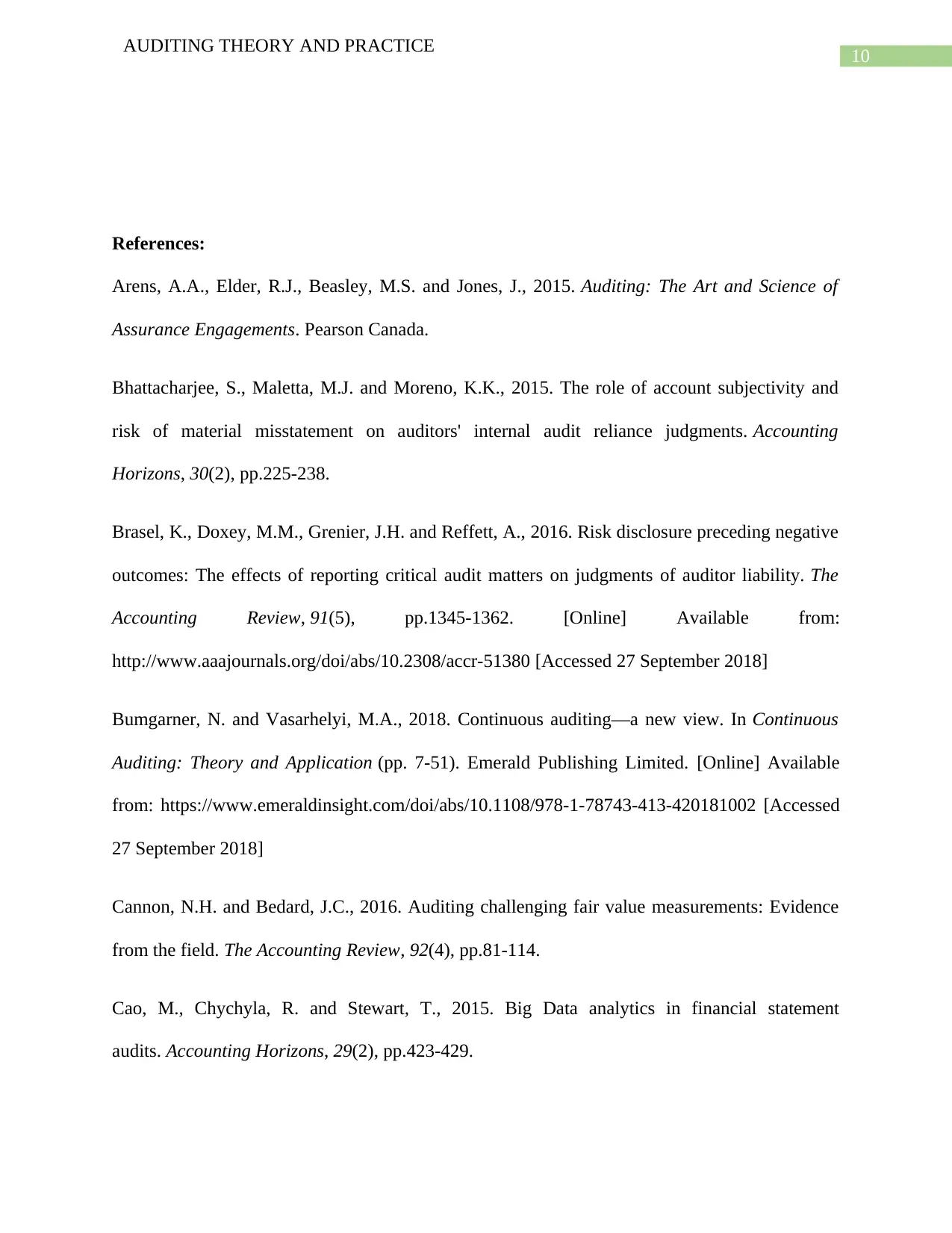
10
AUDITING THEORY AND PRACTICE
References:
Arens, A.A., Elder, R.J., Beasley, M.S. and Jones, J., 2015. Auditing: The Art and Science of
Assurance Engagements. Pearson Canada.
Bhattacharjee, S., Maletta, M.J. and Moreno, K.K., 2015. The role of account subjectivity and
risk of material misstatement on auditors' internal audit reliance judgments. Accounting
Horizons, 30(2), pp.225-238.
Brasel, K., Doxey, M.M., Grenier, J.H. and Reffett, A., 2016. Risk disclosure preceding negative
outcomes: The effects of reporting critical audit matters on judgments of auditor liability. The
Accounting Review, 91(5), pp.1345-1362. [Online] Available from:
http://www.aaajournals.org/doi/abs/10.2308/accr-51380 [Accessed 27 September 2018]
Bumgarner, N. and Vasarhelyi, M.A., 2018. Continuous auditing—a new view. In Continuous
Auditing: Theory and Application (pp. 7-51). Emerald Publishing Limited. [Online] Available
from: https://www.emeraldinsight.com/doi/abs/10.1108/978-1-78743-413-420181002 [Accessed
27 September 2018]
Cannon, N.H. and Bedard, J.C., 2016. Auditing challenging fair value measurements: Evidence
from the field. The Accounting Review, 92(4), pp.81-114.
Cao, M., Chychyla, R. and Stewart, T., 2015. Big Data analytics in financial statement
audits. Accounting Horizons, 29(2), pp.423-429.
AUDITING THEORY AND PRACTICE
References:
Arens, A.A., Elder, R.J., Beasley, M.S. and Jones, J., 2015. Auditing: The Art and Science of
Assurance Engagements. Pearson Canada.
Bhattacharjee, S., Maletta, M.J. and Moreno, K.K., 2015. The role of account subjectivity and
risk of material misstatement on auditors' internal audit reliance judgments. Accounting
Horizons, 30(2), pp.225-238.
Brasel, K., Doxey, M.M., Grenier, J.H. and Reffett, A., 2016. Risk disclosure preceding negative
outcomes: The effects of reporting critical audit matters on judgments of auditor liability. The
Accounting Review, 91(5), pp.1345-1362. [Online] Available from:
http://www.aaajournals.org/doi/abs/10.2308/accr-51380 [Accessed 27 September 2018]
Bumgarner, N. and Vasarhelyi, M.A., 2018. Continuous auditing—a new view. In Continuous
Auditing: Theory and Application (pp. 7-51). Emerald Publishing Limited. [Online] Available
from: https://www.emeraldinsight.com/doi/abs/10.1108/978-1-78743-413-420181002 [Accessed
27 September 2018]
Cannon, N.H. and Bedard, J.C., 2016. Auditing challenging fair value measurements: Evidence
from the field. The Accounting Review, 92(4), pp.81-114.
Cao, M., Chychyla, R. and Stewart, T., 2015. Big Data analytics in financial statement
audits. Accounting Horizons, 29(2), pp.423-429.
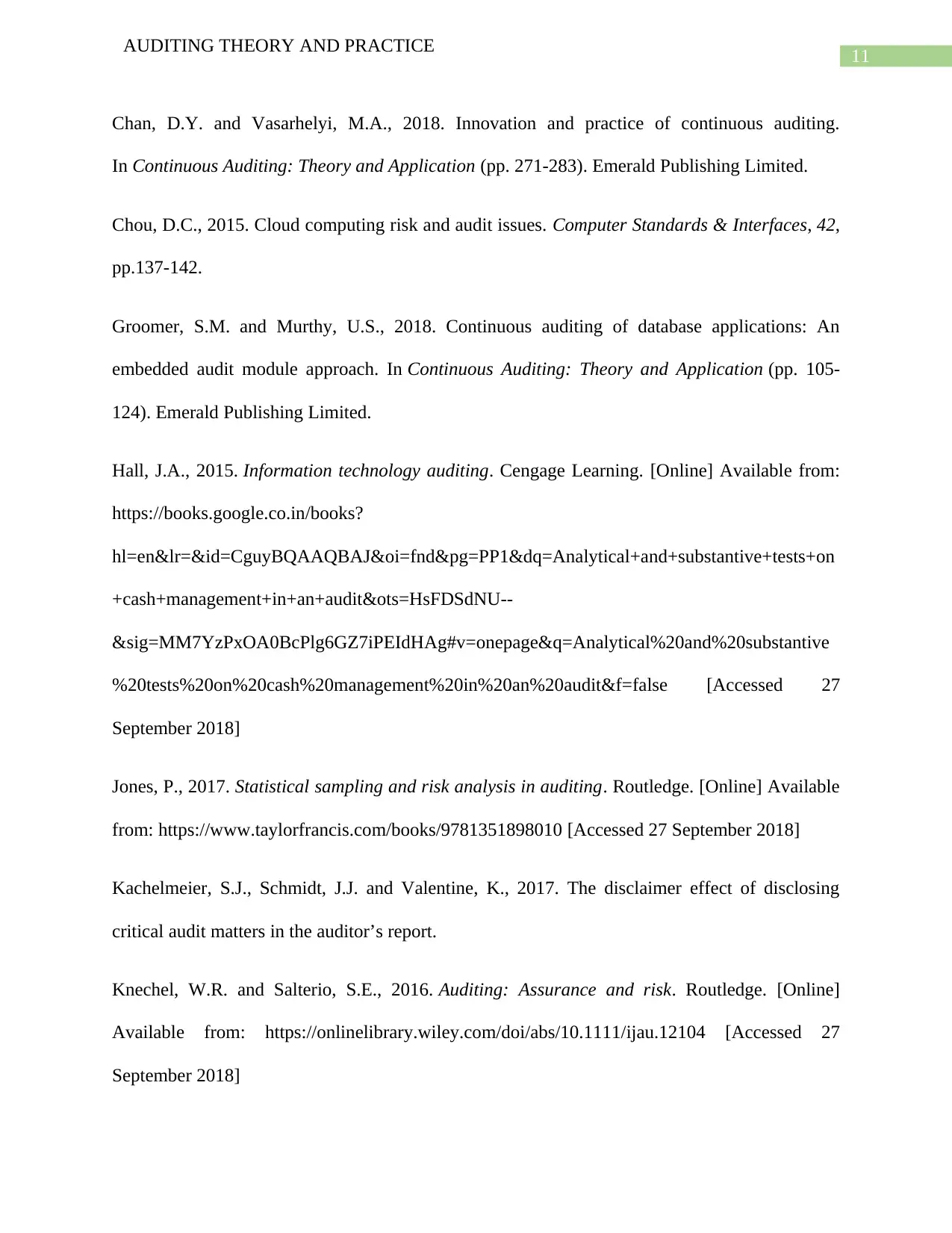
11
AUDITING THEORY AND PRACTICE
Chan, D.Y. and Vasarhelyi, M.A., 2018. Innovation and practice of continuous auditing.
In Continuous Auditing: Theory and Application (pp. 271-283). Emerald Publishing Limited.
Chou, D.C., 2015. Cloud computing risk and audit issues. Computer Standards & Interfaces, 42,
pp.137-142.
Groomer, S.M. and Murthy, U.S., 2018. Continuous auditing of database applications: An
embedded audit module approach. In Continuous Auditing: Theory and Application (pp. 105-
124). Emerald Publishing Limited.
Hall, J.A., 2015. Information technology auditing. Cengage Learning. [Online] Available from:
https://books.google.co.in/books?
hl=en&lr=&id=CguyBQAAQBAJ&oi=fnd&pg=PP1&dq=Analytical+and+substantive+tests+on
+cash+management+in+an+audit&ots=HsFDSdNU--
&sig=MM7YzPxOA0BcPlg6GZ7iPEIdHAg#v=onepage&q=Analytical%20and%20substantive
%20tests%20on%20cash%20management%20in%20an%20audit&f=false [Accessed 27
September 2018]
Jones, P., 2017. Statistical sampling and risk analysis in auditing. Routledge. [Online] Available
from: https://www.taylorfrancis.com/books/9781351898010 [Accessed 27 September 2018]
Kachelmeier, S.J., Schmidt, J.J. and Valentine, K., 2017. The disclaimer effect of disclosing
critical audit matters in the auditor’s report.
Knechel, W.R. and Salterio, S.E., 2016. Auditing: Assurance and risk. Routledge. [Online]
Available from: https://onlinelibrary.wiley.com/doi/abs/10.1111/ijau.12104 [Accessed 27
September 2018]
AUDITING THEORY AND PRACTICE
Chan, D.Y. and Vasarhelyi, M.A., 2018. Innovation and practice of continuous auditing.
In Continuous Auditing: Theory and Application (pp. 271-283). Emerald Publishing Limited.
Chou, D.C., 2015. Cloud computing risk and audit issues. Computer Standards & Interfaces, 42,
pp.137-142.
Groomer, S.M. and Murthy, U.S., 2018. Continuous auditing of database applications: An
embedded audit module approach. In Continuous Auditing: Theory and Application (pp. 105-
124). Emerald Publishing Limited.
Hall, J.A., 2015. Information technology auditing. Cengage Learning. [Online] Available from:
https://books.google.co.in/books?
hl=en&lr=&id=CguyBQAAQBAJ&oi=fnd&pg=PP1&dq=Analytical+and+substantive+tests+on
+cash+management+in+an+audit&ots=HsFDSdNU--
&sig=MM7YzPxOA0BcPlg6GZ7iPEIdHAg#v=onepage&q=Analytical%20and%20substantive
%20tests%20on%20cash%20management%20in%20an%20audit&f=false [Accessed 27
September 2018]
Jones, P., 2017. Statistical sampling and risk analysis in auditing. Routledge. [Online] Available
from: https://www.taylorfrancis.com/books/9781351898010 [Accessed 27 September 2018]
Kachelmeier, S.J., Schmidt, J.J. and Valentine, K., 2017. The disclaimer effect of disclosing
critical audit matters in the auditor’s report.
Knechel, W.R. and Salterio, S.E., 2016. Auditing: Assurance and risk. Routledge. [Online]
Available from: https://onlinelibrary.wiley.com/doi/abs/10.1111/ijau.12104 [Accessed 27
September 2018]
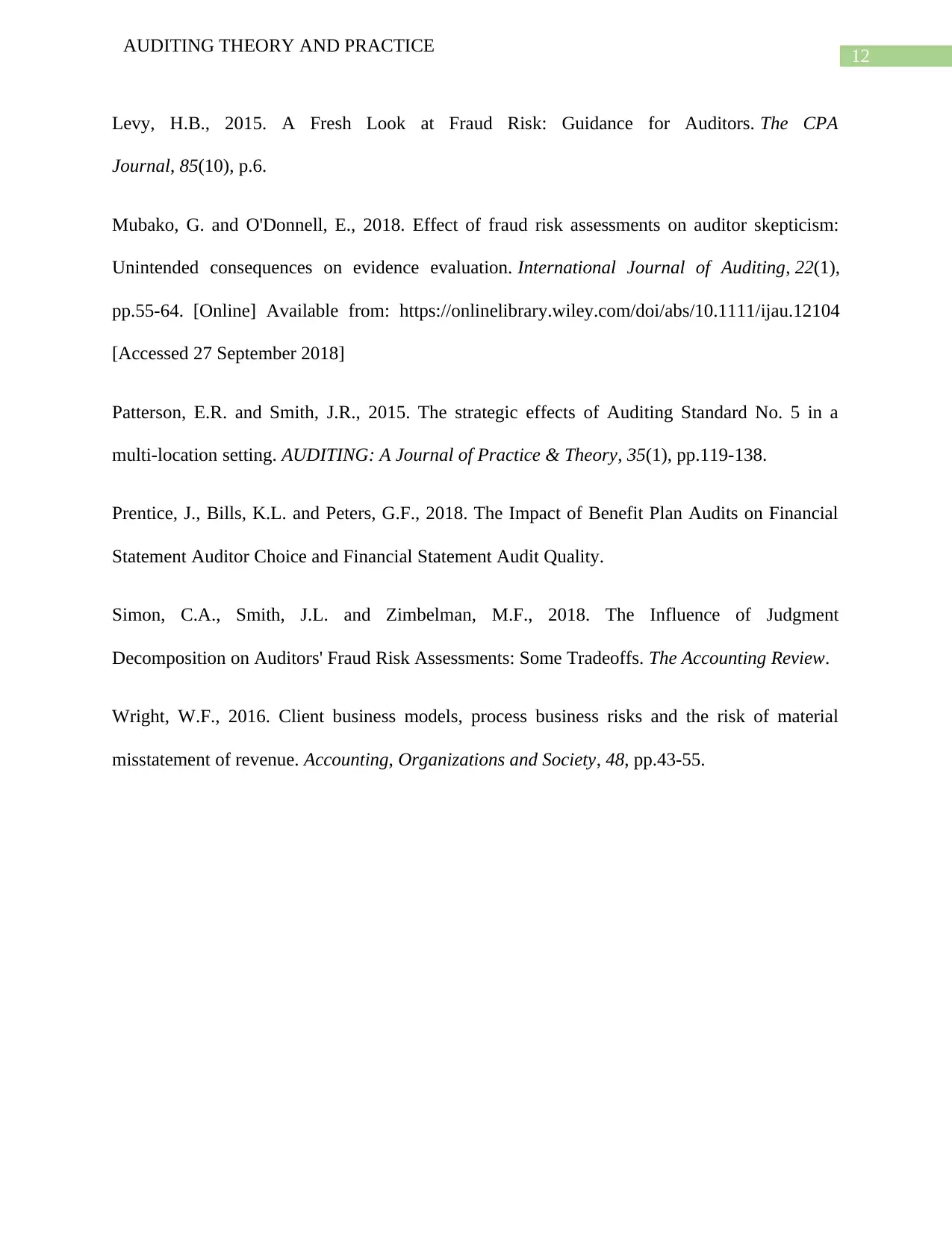
12
AUDITING THEORY AND PRACTICE
Levy, H.B., 2015. A Fresh Look at Fraud Risk: Guidance for Auditors. The CPA
Journal, 85(10), p.6.
Mubako, G. and O'Donnell, E., 2018. Effect of fraud risk assessments on auditor skepticism:
Unintended consequences on evidence evaluation. International Journal of Auditing, 22(1),
pp.55-64. [Online] Available from: https://onlinelibrary.wiley.com/doi/abs/10.1111/ijau.12104
[Accessed 27 September 2018]
Patterson, E.R. and Smith, J.R., 2015. The strategic effects of Auditing Standard No. 5 in a
multi-location setting. AUDITING: A Journal of Practice & Theory, 35(1), pp.119-138.
Prentice, J., Bills, K.L. and Peters, G.F., 2018. The Impact of Benefit Plan Audits on Financial
Statement Auditor Choice and Financial Statement Audit Quality.
Simon, C.A., Smith, J.L. and Zimbelman, M.F., 2018. The Influence of Judgment
Decomposition on Auditors' Fraud Risk Assessments: Some Tradeoffs. The Accounting Review.
Wright, W.F., 2016. Client business models, process business risks and the risk of material
misstatement of revenue. Accounting, Organizations and Society, 48, pp.43-55.
AUDITING THEORY AND PRACTICE
Levy, H.B., 2015. A Fresh Look at Fraud Risk: Guidance for Auditors. The CPA
Journal, 85(10), p.6.
Mubako, G. and O'Donnell, E., 2018. Effect of fraud risk assessments on auditor skepticism:
Unintended consequences on evidence evaluation. International Journal of Auditing, 22(1),
pp.55-64. [Online] Available from: https://onlinelibrary.wiley.com/doi/abs/10.1111/ijau.12104
[Accessed 27 September 2018]
Patterson, E.R. and Smith, J.R., 2015. The strategic effects of Auditing Standard No. 5 in a
multi-location setting. AUDITING: A Journal of Practice & Theory, 35(1), pp.119-138.
Prentice, J., Bills, K.L. and Peters, G.F., 2018. The Impact of Benefit Plan Audits on Financial
Statement Auditor Choice and Financial Statement Audit Quality.
Simon, C.A., Smith, J.L. and Zimbelman, M.F., 2018. The Influence of Judgment
Decomposition on Auditors' Fraud Risk Assessments: Some Tradeoffs. The Accounting Review.
Wright, W.F., 2016. Client business models, process business risks and the risk of material
misstatement of revenue. Accounting, Organizations and Society, 48, pp.43-55.
1 out of 13
Related Documents
Your All-in-One AI-Powered Toolkit for Academic Success.
+13062052269
info@desklib.com
Available 24*7 on WhatsApp / Email
![[object Object]](/_next/static/media/star-bottom.7253800d.svg)
Unlock your academic potential
© 2024 | Zucol Services PVT LTD | All rights reserved.



